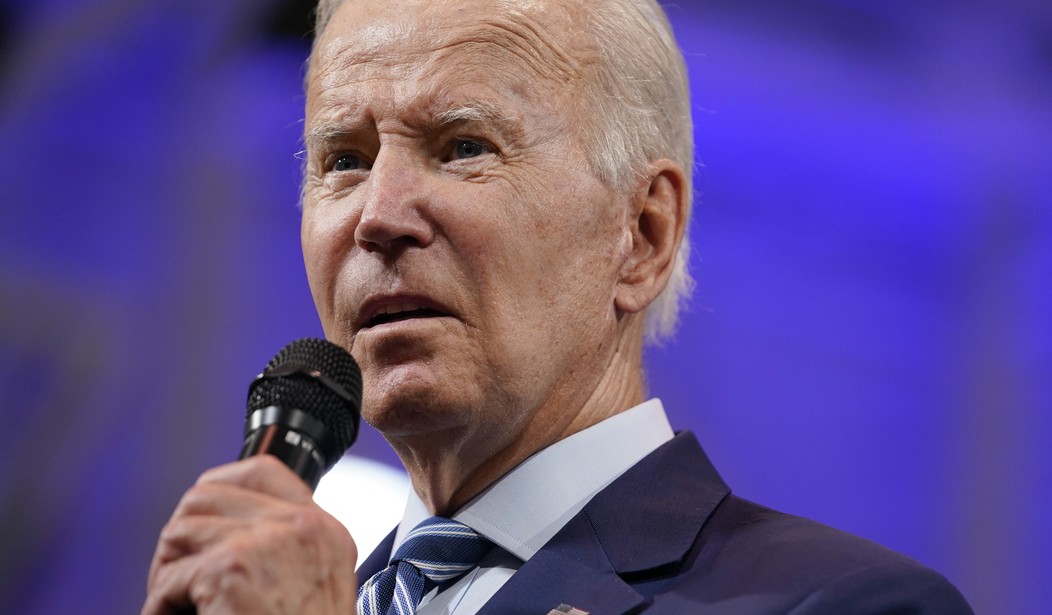You better believe that Joe Biden and his team knew that already, too. He managed to buy midterm votes without spending a dollar, and now he can play the victim for another couple of years to hang onto those voters, who will end up with nothing at all.
At least one judge decided that the Constitution might be a little more important than “standing” when it comes to Biden’s unilateral appropriation of several hundred billion dollars. In fact, the insult to the separation of powers and Congress’ exclusive power of the purse is grave enough that Judge Mark Pittman decided to dispense with the plaintiff’s request for an injunction and proceeded to decide the case immediately, vacating Biden’s executive order:
A federal judge in Texas on Thursday struck down the Biden administration’s student-debt forgiveness plan, imperiling a key administration priority that would have canceled up to $20,000 in student loans for tens of millions of borrowers.
The Biden administration’s plan is an “unconstitutional exercise of Congress’s legislative power” that also failed to go through normal regulatory processes, Judge Mark Pittman of the Northern District of Texas wrote in a 26-page opinion.
“No one can plausibly deny that it is either one of the largest delegations of legislative power to the executive branch, or one of the largest exercises of legislative power without congressional authority in the history of the United States,” Mr. Pittman, an appointee of former President Donald Trump wrote.
The Biden administration can appeal the verdict.
We’ll get to the appeal issue in a moment. First, let’s take a look at Judge Pittman’s reasoning at going directly to the merits. Federal judges have authority to consolidate phases of the process where judges see a need to proceed directly to the merits. And, Pittman writes in his judgment, this is definitely one of those cases for which this authority exists, especially in regard to violations of the Administrative Procedure Act (APA) alleged by plaintiffs:
Under Federal Rule of Civil Procedure 65, “[b]efore or after beginning the hearing on a motion for a preliminary injunction, the court may advance the trial on the merits and consolidate it with the hearing.” FED. R. CIV. P. 65(a)(2) (emphasis added). But if “the eventual outcome on the merits is plain at the preliminary injunction stage, the judge should, after due notice to the parties, merge the stages and enter a final judgment.” Curtis 1000, Inc. v. Suess, 24 F.3d 941, 945 (7th Cir. 1994) (emphasis added). Courts typically require that the parties “receive clear and unambiguous notice [of the court’s intent to consolidate the trial and the hearing] either before the hearing commences or at a time which will still afford the parties a full opportunity to present their respective cases.” Univ. of Tex. v. Camenisch, 451 U.S. 390, 395 (1981) (quoting Pughsley v. 3750 Lake Shore Drive Coop. Bldg., 463 F.2d 1055, 1057 (7th Cir. 1972)) (alteration in original). Courts may also consolidate without giving the parties notice if the lack of notice is not prejudicial to either party. See Wohlfahrt v. Mem’l Med. Ctr., 658 F.2d 416, 418 (5th Cir. 1981).
If consolidation is appropriate, a district court may convert a plaintiff’s preliminary-injunction motion into a motion for summary judgment. H & W Indus., Inc. v. Formosa Plastics Corp., USA, 860 F.2d 172, 177 (5th Cir. 1988). “Summary judgment serves as ‘the mechanism for deciding, as a matter of law, whether the agency action is . . . consistent with the APA.’”
As for standing, Pittman sees through the Biden administration’s arguments that no private plaintiffs could possibly establish standing, disagreeing strenuously to that claim:
Defendants seem to argue that no one has standing to challenge the Program because where the government is providing a benefit, nobody is harmed by the existence of that benefit. ECF No. 32 at 57–58. And according to Defendants, “sometimes the result is that there is executive or legislative action for which there isn’t an appropriate plaintiff.” Id. at 57 (emphasis added). The Court must disagree. The Supreme Court has recognized that a plaintiff has standing to challenge a government benefit in many cases. See, e.g., Ne. Fla. Chapter of Associated Gen. Contractors of Am. v. City of Jacksonville, 508 U.S. 656, 666 (1993) (holding that plaintiffs who did not qualify for government benefits had standing); Bowsher v. Synar, 478 U.S. 714, 721, (1986) (holding that the failure to receive benefits is enough to confer Article III standing). …
Plaintiffs have a concrete interest in having their debts forgiven to a greater degree. Brown is ineligible for the Program because her loans are commercially held. And Taylor is ineligible for the full $20,000 in debt forgiveness under the Program because he did not receive a Pell Grant in college. Brown and Taylor’s inability to obtain the full benefit of debt forgiveness under the Program flows directly from the Program’s eligibility requirements. Thus, Defendants’ procedural error of not providing for a notice-and-comment period—which the Court must assume as true for standing—deprived Plaintiffs of “a non-illusory opportunity to pursue [the] benefit” of greater debt forgiveness and an opportunity to advocate for the expansion of the eligibility criteria of the Program. Ecosystem Inv. Partners v. Crosby Dredging, LLC, 729 F. App’x 287, 292 (5th Cir. 2018).
In making this argument, Pittman no doubt had his eye on the Biden administration’s attempts to change the parameters of the loan-forgiveness program to undermine standing in other lawsuits. That trick worked to sideline a couple of other challenges by changing the rules just enough to moot those complaints while judges considered temporary-injunction requests. As I wrote before, that kind of chicanery would eventually backfire by convincing a judge that the Biden administration was not only acting arbitrarily and capriciously but also flat-out attempting to manipulate the courts.
That may well be why Pittman decided to consolidate the phases and go right to a ruling on the merits. He likely didn’t want to leave enough time for Biden’s Department of Education to address the points raised by these plaintiffs on standing. By using the APA issue to get past standing and then consolidating the phases, Pittman then could jump directly not to the specific injuries these plaintiffs raised but the core constitutional insult Biden created with his arrogation of Article I authority. Pittman also took a barely veiled swipe at Barack Obama in his conclusion:
This case involves the question of whether Congress—through the HEROES Act—gave the Secretary authority to implement a Program that provides debt forgiveness to millions of student-loan borrowers, totaling over $400 billion. Whether the Program constitutes good public policy is not the role of this Court to determine.21 Still, no one can plausibly deny that it is either one of the largest delegations of legislative power to the executive branch, or one of the largest exercises of legislative power without congressional authority in the history of the United States.
In this country, we are not ruled by an all-powerful executive with a pen and a phone. Instead, we are ruled by a Constitution that provides for three distinct and independent branches of government. As President James Madison warned, “[t]he accumulation of all powers, legislative, executive, and judiciary, in the same hands, whether of one, a few, or many, and whether hereditary, self-appointed, or elective, may justly be pronounced the very definition of tyranny.” THE FEDERALIST NO. 47.
The Court is not blind to the current political division in our country. But it is fundamental to the survival of our Republic that the separation of powers as outlined in our Constitution be preserved. And having interpreted the HEROES Act, the Court holds that it does not provide “clear congressional authorization” for the Program proposed by the Secretary.
Thus, Plaintiffs’ Motion for Summary Judgment (ECF No. 3) is GRANTED and Defendants’ Motion to Dismiss (ECF No. 25) is DENIED. And the Court DECLARES UNLAWFUL and VACATES the Program.
That unwinds the entire program, not just blocks it in regard to one case or in a specific jurisdiction. Pittman makes that intent crystal clear in this opinion. Unless the Biden administration gets this vacatur overturned on appeal, his Academia bailout comes to a screeching halt before it ever began.
So will they appeal? Biden really has no choice, politically speaking, even though he got almost all of the political benefit he was going to get out of this debt-forgiveness proposal on Tuesday. He can still get some political juice out of this, but only if he’s seen as keeping up a fight to get it reinstated. The prospects for an appeal seem dim; it would have to go through the Fifth Circuit, which has shown itself particularly skeptical about executive overreach in the past — and not even on the scale of this clear-cut constitutional violation. Failing that, Biden would have to seek relief at the Supreme Court, and … that venue doesn’t look promising either.
But even if the Fifth Circuit found a reversible error in Pittman’s reasoning here, especially on standing, it would take long enough to act that the all-but-certain new Republican House would then be in place. They will likely also sue to stop the usurpation of Congress’ exclusive power of appropriation, and their standing and injury is both obvious and undeniable. This program was always destined for a court-ordered shutdown. It just arrived earlier than expected … thankfully.








Join the conversation as a VIP Member